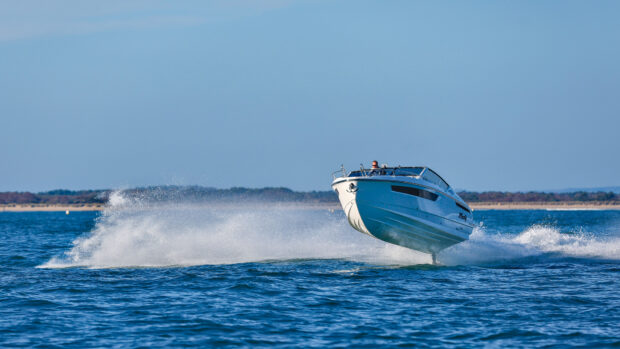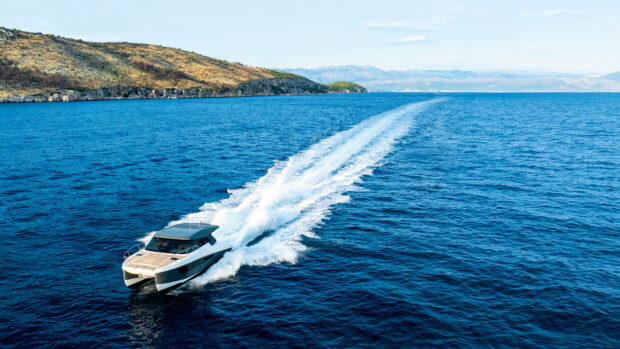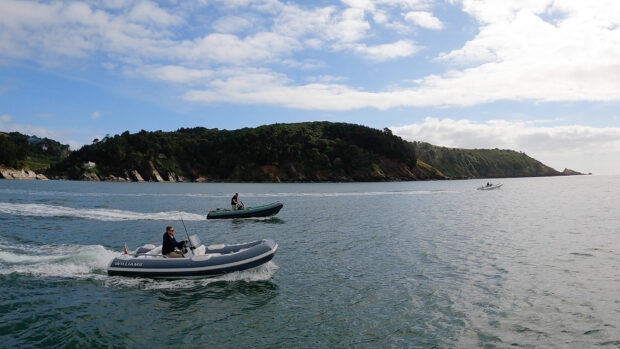The new X Shore Eelex 8000 may be electric but it’s also fast, fun and surprisingly sexy
It’s no coincidence that when Elon Musk launched Tesla, the very first model was a sexy convertible sportscar based on the chassis of a Lotus Elise. From an engineering point of view a small, practical city car would have made a lot more sense as a pure electric vehicle but Musk realised early on that sensible doesn’t sell, especially when you’re asking big bucks for it.
He didn’t want Tesla to be just an eco-friendly car for city-dwelling tree-huggers but a hip brand that everyone from celebrities to tech billionaires wanted to be seen in.
Konrad Bergstrom, the Swedish tech millionaire behind X Shore electric boats, makes no bones about wanting to emulate that pattern of success with his own Tesla of the seas. His stated aim is that every boat in the X Shore range must be capable of 40 knots, be able to run for two hours at 25 knots and have a range of 100nm at 10-12 knots. In other words it needs to perform as well as a petrol-powered sportsboat but without the noise and pollution.

Konrad Bergstrom has spent €10 million developing X Shore
“An electric boat should be better than an electric car,” insists Konrad. “Above 50kmh the tyre noise of an electric car is really annoying, but in a boat you only hear the pleasant sound of water breaking against the hull. Because boats are open you also notice the fumes of a petrol engine much more than you do in a car.”
So far so logical but as he soon discovered, matching the performance and range of a petrol sportsboat using electric power is no easy task. Water is 784 times denser than air and takes a lot more energy than rolling a car along a flat road. “It’s like a car driving up a 45 degree hill all the time,” points out Konrad.
The first prototype managed just 25 knots and made “a terrible noise” from the shaft bearings – a sound which is normally drowned out by the volume of a combustion engine.
Article continues below…

Iguana X100: Amphibious boat is much better for being a little cheaper

VIDEO: Greenline NEO review
The solution was to design a pure electric boat rather than trying to mimic an existing one. Without the resources to develop its own electric motor and battery pack, X Shore focused instead on four areas of the boat they felt they could improve; the hull, drivetrain, propeller and rudder.
The hull
The original prototype used a relatively conventional twin-stepped hull but a chance meeting with a naval architect and 3,000 hours of subsequent testing at Rolls-Royce’s marine engineering facility suggested a single, much deeper 37cm step could reduce drag by up to 30%.

The step is over 1ft deep, keeping the middle section of the hull and shaft clear of the water
Effectively it splits the planing surface into two distinct sections fore and aft with clear air between them, allowing it to plane at speeds as low as 8-10 knots. In displacement mode, it’s actually less efficient than a round bilge design but that’s a compromise X Shore is happy to live with. The deep step is also what makes its decision to go with an exposed shaft drive more understandable.
The drivetrain
Conventional logic suggests that a slippery sterndrive would create less drag and produce a more efficient horizontal thrust than an angled exposed shaft and rudder, albeit at the expense of increased internal friction from the transfer boxes.
However, by mounting the electric motor much further forward than normal (it sits directly in front of the hull step) and as low down as possible, the angle of the shaft is only 3.5 degrees off the horizontal. And thanks to that deep step the majority of the shaft is running in air with just the propeller and the last few inches of it immersed in water.

The interlocking teeth of the cogs are fitted with powerful opposing magnets to ensure they never actually touch, thereby eliminating the main source of both noise and friction
X Shore did look at pods, sterndrives and even waterjets as well as enclosed shafts but taking everything into account a slim exposed shaftdrive was calculated to be the most efficient.
The final part of the drivetrain equation is an innovative gearbox based on that of a wind turbine. The teeth of the interlinking cogs never touch, relying on powerful opposing magnets rather than physical pressure to turn them. This eliminates the main source of both friction and noise.
The propeller
All propellers are a compromise between speed, acceleration and efficiency, but X Shore had another characteristic to factor in – cavitation noise. There would be no point in creating silent running gear if the propeller stirred up a terrible racket, as anyone with a bow thruster can testify to.
Again, X Shore searched outside the box for inspiration, paying particular attention to the design of naval minesweeper propellers where noise and vibration is literally a matter of life and death. They settled on a four-bladed design that proved quieter than most three- or five-bladed designs without compromising performance.
The rudder
That just left the design of the rudder to complete the jigsaw. Most single-engined craft, even high speeds ones, require a sizeable rudder to give them any chance of handling properly at low speeds. Unfortunately that also creates a significant amount of drag at higher speeds.

The X Shore’s modern, minimalist looks should appeal to early adopters
X Shore’s solution was to go for a smaller, thinner steerable skeg that would deliver sufficient turning power at speed and simply find an alternative means of manoeuvring the boat around the marina. The answer was a pressurised waterjet system with a nozzle at each corner to push the bow or stern in the direction it needs to go.
Proof in the pudding
We had hoped to carry out a proper sea trial of the Eelex 8000 prototype prior to writing this. Unfortunately, a gremlin in the electronic brain controlling the main 140kW motor refused to let us experience anything more than a five-minute pootle around the marina, even though it had been working fine before our arrival and was fixed soon after we left.
So while we can’t provide confirmation of X-Shore’s performance and range claims, we can comment on its static appeal and the unusual sensation of helming a boat with a cork dial for a throttle, a single 24in touchscreen replacing all the usual switchgear and a multifunction wheel which spins around a fixed hub.

24in touchscreen MFD and multi-function wheel replace the usual switches and gauges
The most obvious difference was the lack of engine noise – although there was a noticeable whine from a water pump used to lubricate the shaft, which they plan to replace on production models. The rotary dial used to control speed (there is no need to engage gears on an electric boat) is surprisingly intuitive but it will be interesting to see how controllable it feels at speed on a lumpy sea.
The design of the boat itself is also a bit Marmite. It certainly looks different to anything else on the water and it does have a funky, modern, minimalist appeal to it. The cork decks, saddle leather upholstery and glass helm all look and feel expensive while the deep coamings and uncluttered decks make it safe and easy to move around. However, we’re not so convinced by the open transom or the comfort and support of those plywood seats, especially on a long or lumpy journey.
The reality is that like that first Tesla, the Eelex 8000 only needs to appeal to a handful of wealthy early adopters when deliveries start later this summer at a cost of around €300,000. The real proof of the pudding will be what comes next.
Konrad is adamant that in time X Shore will develop a smaller, simpler model delivering all the same performance goals for under €100,000. But before he can do that he needs scale. Scale and a few like-minded celebs and tech millionaires to do what they did for Tesla’s image.
Specification
LOA: 26ft 3in (8.0m)
Beam: 8ft 6in (2.6m)
Draught: 2ft 7in (0.8m)
Motor: 220kW (299hp)
Top speed: 40 knots
Cruising speed: 25 knots
Range: 100nm @ 10 knots
Price: €300,000









